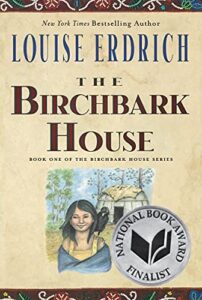The Birchbark House (The Birchbark House #1)
Louise Erdrich
Hyperion Books for Children
Published June 3, 2002 (orig. 1999)
Amazon | Bookshop | Goodreads
About The Birchbark House
Nineteenth-century American pioneer life was introduced to thousands of young readers by Laura Ingalls Wilder’s beloved Little House books. With THE BIRCHBARK HOUSE, award-winning author Louise Erdrich’s first novel for young readers, this same slice of history is seen through the eyes of the spirited, 7-year-old Ojibwa girl Omakayas, or Little Frog, so named because her first step was a hop. The sole survivor of a smallpox epidemic on Spirit Island, Omakayas, then only a baby girl, was rescued by a fearless woman named Tallow and welcomed into an Ojibwa family on Lake Superior’s Madeline Island, the Island of the Golden-Breasted Woodpecker. We follow Omakayas and her adopted family through a cycle of four seasons in 1847, including the winter, when a historically documented outbreak of smallpox overtook the island.
Readers will be riveted by the daily life of this Native American family, in which tanning moose hides, picking berries, and scaring crows from the cornfield are as commonplace as encounters with bear cubs and fireside ghost stories. Erdrich–a member of the Turtle Mountain Band of Ojibwa–spoke to Ojibwa elders about the spirit and significance of Madeline Island, read letters from travelers, and even spent time with her own children on the island, observing their reactions to woods, stones, crayfish, bear, and deer.
The author’s softly hewn pencil drawings infuse life and authenticity to her poetic, exquisitely wrought narrative. Omakayas is an intense, strong, likable character to whom young readers will fully relate–from her mixed emotions about her siblings, to her discovery of her unique talents, to her devotion to her pet crow Andeg, to her budding understanding of death, life, and her role in the natural world. We look forward to reading more about this brave, intuitive girl–and wholeheartedly welcome Erdrich’s future series to the canon of children’s classics. (Ages 9 and older) –Karin Snelson
My Review
This book has been on my reading list for a super long time. I’m really glad I was finally able to read it. I own a hard copy of THE BIRCHBARK HOUSE, but I discovered the audiobook version is included in my Audible membership, so I listened to it through that app.
For the most part, this is a really gentle story– the same sort of tempo as LITTLE HOUSE ON THE PRAIRIE, but focused on the lives of an Ojibwa family. Omakayas navigates feelings of envy, annoyance, and love for her siblings. She discovers a connection with a family of bears in the forest. A crow becomes a beloved pet.
I loved the moments of mischief and childhood fun. Omakayas hears stories from her father and grandmother. She forges connections with her youngest brother and with an older woman, a hunter who leaves gifts with her family and seems to have a special place in her heart for Omakayas.
It’s such a sweet story, and so beautifully told. THE BIRCHBARK HOUSE is the first in a series of five books. After reading this one, I think I’d enjoy reading the rest of the series. I would definitely recommend this book to readers who enjoy historical fiction, especially life in America in the 1800s.
Content Notes
Recommended for Ages 8 to 12.
Representation
Omakayas and her family are members of the Ojibwe tribe.
Profanity/Crude Language Content
None.
Romance/Sexual Content
Omakayas briefly worries about what will happen when her older sister marries and creates a home of her own.
Spiritual Content
Omakayas sees her grandmother leave tobacco as an offering when she takes birchbark from a tree. She prays to the spirits for protection and safety for her family. They celebrate the coming of winter with other families in the tribe. Omakayas begins to dream and connect with the spirit of the bear, a healing animal. This means she will be a healer, like her grandmother.
Violent Content
Situations of peril. Some descriptions of illness (smallpox) and death.
Drug Content
Omakayas’ grandmother and other adults smoke tobacco in a pipe.
Note: This post contains affiliate links, which do not cost you anything to use, but which help support this blog.
